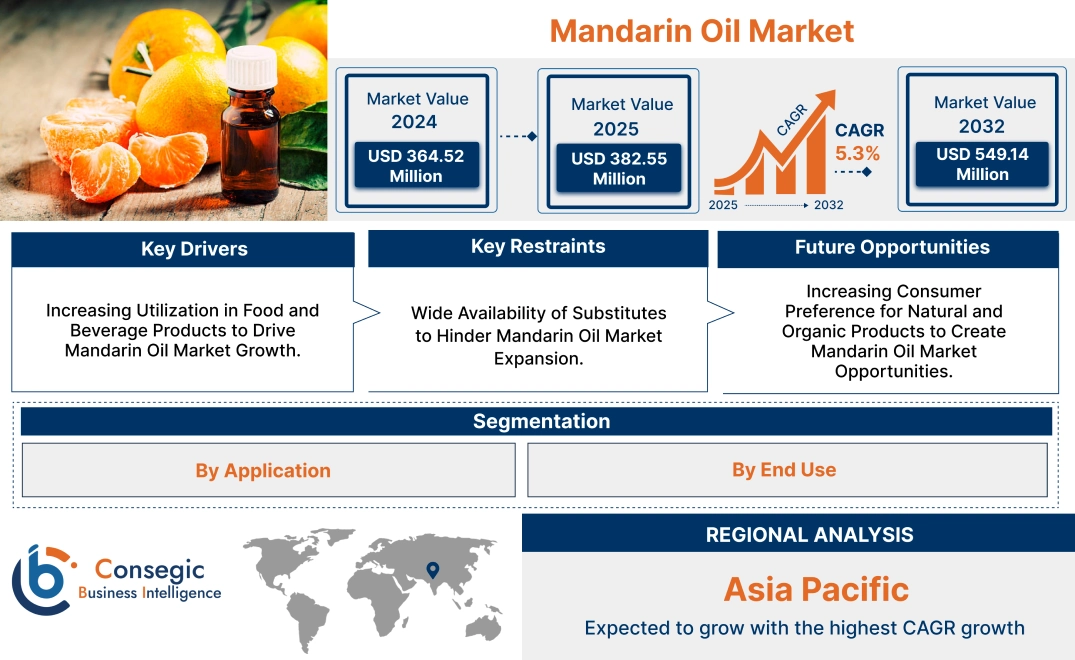Mandarin Oil Market Size:
The Mandarin Oil Market size is growing with a CAGR of 5.3% during the forecast period (2025-2032), and the market is projected to be valued at USD 549.14 Million by 2032 from USD 364.52 Million in 2024. Additionally, the market value for 2025 is attributed to USD 382.55 Million.
Mandarin Oil Market Scope & Overview:
Mandarin oil is an essential oil derived from the peel of mandarin oranges. This essential oil is recognized for its distinctly sweet, fresh, and uplifting citrus flavors and aroma. Extracted through methods like cold pressing, this oil is utilized across various industries for its flavors, aroma, and therapeutic properties. It serves as a natural flavoring agent in the food and beverage sector. In aromatherapy products, it is favored for its calming and mood-enhancing effects. The cosmetic and personal care sector incorporates this oil for its pleasant fragrance and potential skin benefits. The growing consumer preference for natural products and the expanding wellness practices contribute to the increasing demand for this essential oil globally.
Mandarin Oil Market Dynamics - (DRO) :
Key Drivers:
Increasing Utilization in Food and Beverage Products to Drive Mandarin Oil Market Growth.
The increasing utilization of mandarin oil in food and beverage products is primarily due to its naturally sweet, fresh, and zesty citrus aroma and flavor, making it a preferred alternative to artificial flavorings. Its versatility allows for application across various food and beverage categories, including beverages, confectionery, baked goods, dairy products, and savory applications such as sauces and marinades. The need for food and beverage products produced using natural ingredients, coupled with growing health awareness among consumers, further fuels this demand as they seek products free from synthetic additives.
- For instance, Ingredion's Global Clean Label Manufacturer research revealed that around 71% of consumers are willing to pay more for current brands that have been reformulated to make claims around the naturalness of their ingredients.
Thus, the growing adoption in food and beverages is driving the mandarin oil market growth.
Rising Popularity of Aromatherapy and Wellness Practices to Accelerate Mandarin Oil Market Expansion.
Aromatherapy involves using essential oils through methods such as massage, topical application, or inhalation to promote balance, harmony, and both psychological and physical well-being. Mandarin orange oil, with its appealing sweet, uplifting, and calming aroma, has become a suitable essential oil in aromatherapy, finding widespread use in aromatherapy diffusers, massage oils, and blends aimed at alleviating stress. The preference for wellness, emphasizing natural and holistic health approaches, has further propelled the adoption of this essential oil as individuals seek natural remedies for both physical and emotional well-being, extending its applications beyond traditional aromatherapy.
- For instance, according to the Global Wellness Institute, the global wellness economy demonstrated significant growth in 2022, expanding by 14% compared to its pre-pandemic share in 2019.
Thus, increasing preference for wellness is driving the mandarin oil market demand.
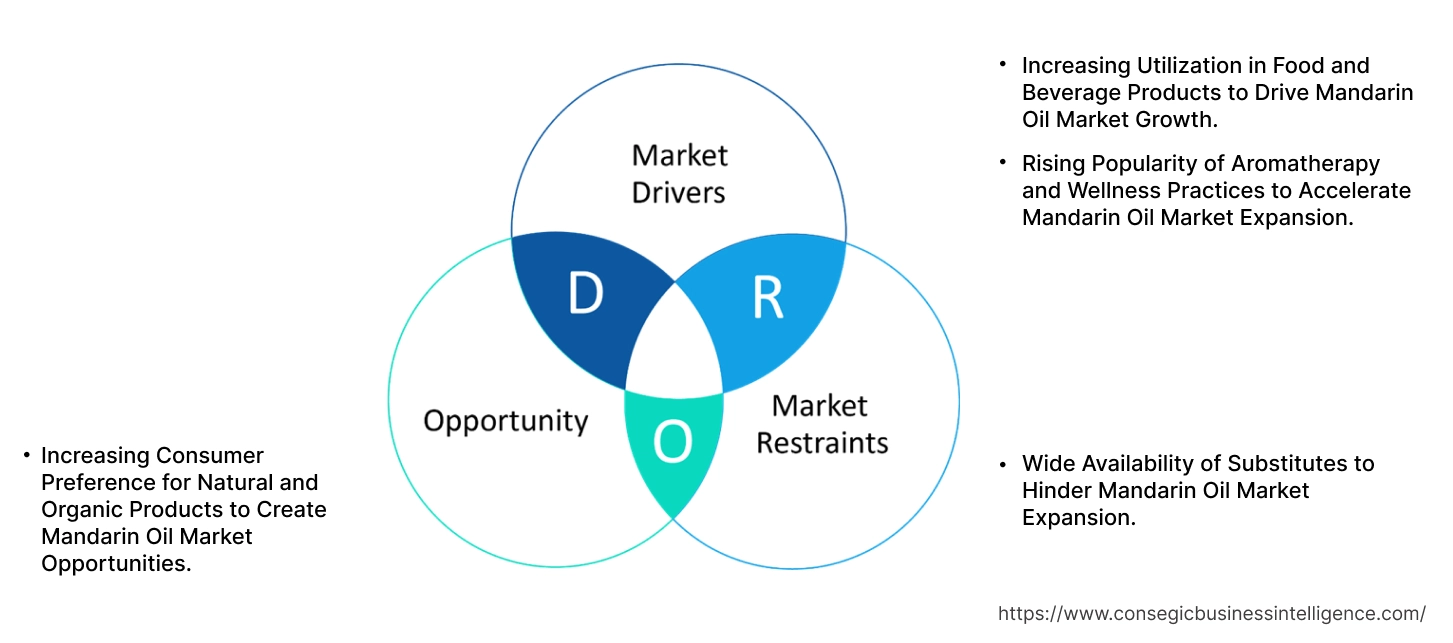
Key Restraints:
Wide Availability of Substitutes to Hinder Mandarin Oil Market Expansion.
The market faces a constraint in its growth due to the widespread presence and established utilization of substitute oils. Compound faces competition with a range of other oils capable of fulfilling similar functions. Sweet orange essential oil is often the closest aromatic substitute for mandarin, offering a similar sweet and uplifting citrus scent with greater availability. Tangerine oil also shares aromatic traits. Bergamot provides a bright citrus alternative with a floral hint. For calming, lavender is versatile for sleep, while chamomile offers a gentle, sweet aroma. Sweet orange also has calming properties, and marjoram is relaxing with a herbaceous scent. In skincare, sweet orange mirrors mandarin's benefits, while other citrus oils offer cleansing properties. This abundance of readily available and competitively priced substitutes creates a competitive landscape and supports players to adopt alternatives. Hence, the aforementioned factors are limiting the mandarin oil market expansion.
Future Opportunities :
Increasing Consumer Preference for Natural and Organic Products to Create Mandarin Oil Market Opportunities.
Across diverse sectors, including cosmetics and personal care, individuals are increasingly seeking out formulations enriched with natural essential oils driven by a desire for gentler and beneficial alternatives to synthetic ingredients. The growing holistic wellness movement further influences this demand, with mandarin oil's calming properties making it a suitable choice for aromatherapy practices. In the food and beverage industry, the clean label preference is prompting a shift towards natural and organic flavoring agents, positioning this oil as a desirable alternative to artificial citrus notes.
- For instance, according to the Acosta Group's 2024 Clean Label Insights Study, a significant majority of consumers, specifically 81%, prioritize purchasing food products with clean labels.
Thus, the growing adoption of natural and organic products across several sectors is expected to create opportunities for the market over future years.
Mandarin Oil Market Segmental Analysis :
By Application:
Based on application, the market is categorized into aromatherapy products, cosmetic & personal care formulations, food & beverage products, pharmaceutical formulations, and others.
Trends in the Application:
- Growing adoption of natural flavoring agents in craft beverages and gourmet food products is positively impacting the market.
- Increasing preference for organic ingredients in cosmetic products is supporting the market revenue.
The food & beverage products segment accounted for the largest mandarin oil market share in 2024.
Essential oil extracted from mandarin is a valued ingredient in food and beverage products due to its sweet, fresh, citrus aroma and flavor. Its versatility allows for application across a wide range of products, from providing a refreshing citrus note in beverages and a sweet tang in confectionery and baked goods to adding a fruity twist in dairy products and a unique citrusy touch in savory sauces and marinades.
The revenue of this segment is significantly driven by increasing consumer preference for natural flavors coupled with the rising health awareness that favors natural ingredients. Stringent regulations on artificial additives also contribute to the rising demand for this oil. As a result, the aforementioned factors make the food and beverage products segment dominant in the market.
The cosmetic & personal care formulations segment is expected to grow at the fastest CAGR over the forecast period.
Mandarin oil serves as a natural ingredient in cosmetics and personal care valued for its sweet, uplifting citrus aroma and skin & hair benefits. As a fragrance, it provides a fresh note in perfumes and body sprays. In skincare, its antiseptic and antioxidant properties aid in cleansing, toning, and moisturizing. It also enhances bath products with its relaxing scent and adds a refreshing aroma & shine to haircare. The increasing global demand for clean beauty and natural alternatives to synthetic chemicals in personal care products supports the segment revenue.
- For instance, according to the 2023 survey analysis published by CleanHub, 63% of respondents across the U.S. said they prefer cosmetic products with natural ingredients.
Hence, owing to the above-mentioned analysis, the cosmetics & personal care formulations segment is expected to grow at the fastest rate over the future years, supporting mandarin oil market demand.
By End Use:
The end use segment is categorized into cosmetics & personal care, food & beverage, pharmaceuticals, and others.
Trends in the End Use:
- The development of functional food and beverage products incorporating natural ingredients is a trend positively impacting the market.
- The increasing popularity of aromatherapy benefits within personal care items is supporting the market revenue.
The food & beverage segment accounted for the largest Mandarin Oil market share of 36.22% in 2024.
Valued for its sweet, fresh, and zesty citrus notes, mandarin oil serves as a suitable natural flavoring in the food and beverage sector. It finds applications in beverages, candies, chocolates, and savory items among others. The growth of this segment is significantly fueled by the increasing consumer preference for natural flavors, the prominent clean label movement, and a rising health awareness that favors natural ingredients.
- For instance, according to the survey data published by According to the 2021 Global Clean Label Manufacturer Study by Ingredion, companies that reformulated their products to meet clean label standards reported an average increase of 15% in their overall revenue.
As a result, as per the mandarin oil market analysis, the food & beverage segment is dominating the mandarin oil market trends.
The cosmetics & personal care segment is expected to grow at the fastest CAGR over the forecast period.
The cosmetics & personal care end-use sector segment is projected to exhibit a rapid growth rate fueled by the growing emphasis on natural and beneficial ingredients. This sector incorporates a wide array of products designed to enhance appearance, cleanse, and protect the skin, hair, and body.
Consumers globally are increasingly prioritizing natural and organic ingredients in their beauty routines, seeking alternatives to synthetic chemicals. Mandarin oil, as a natural essential oil, aligns with this preference. Additionally, the rapidly growing market for certified organic skincare products significantly favors natural essential oils. Hence, the combination of consumer preferences, product efficacy, and sustainability positions the cosmetics & personal care sector as the fastest growing segment in the forecast period.
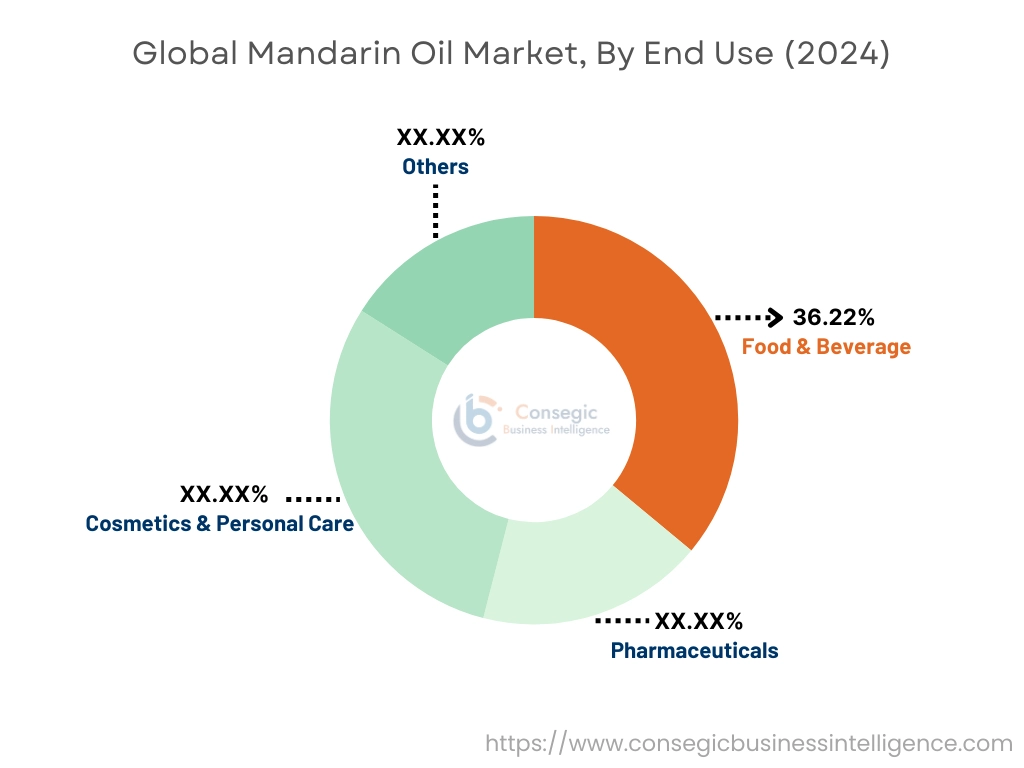
Regional Analysis:
The regional segment includes North America, Europe, Asia Pacific, the Middle East and Africa, and Latin America.
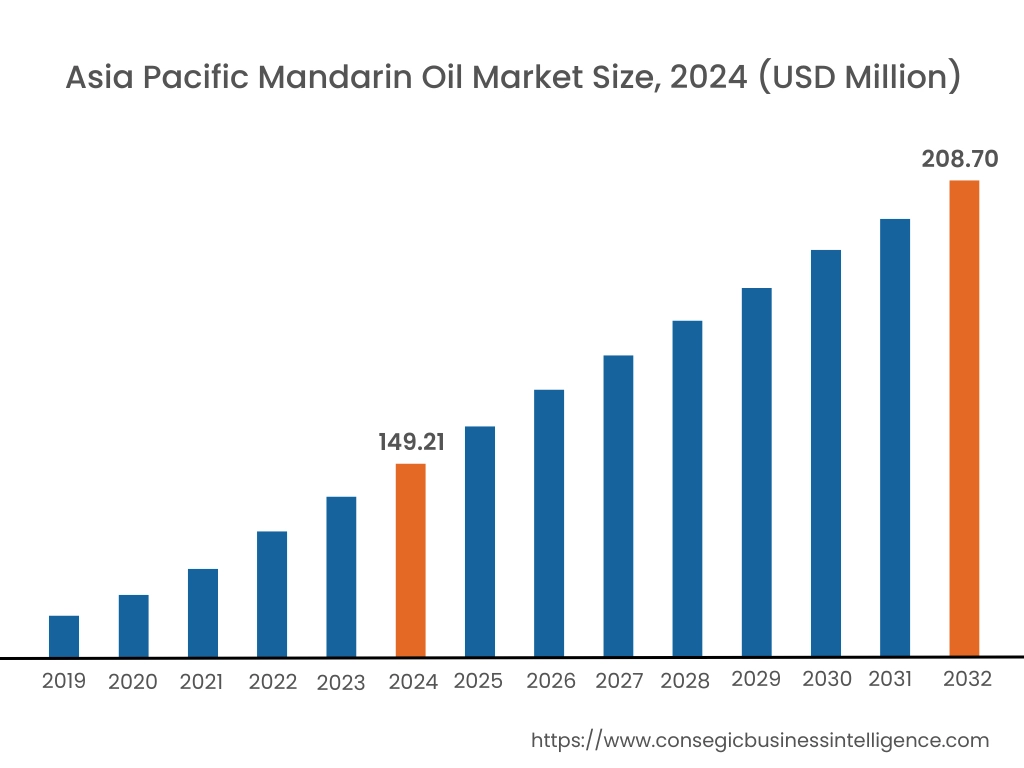
In 2024, Asia Pacific accounted for the highest market share at 40.94% and was valued at USD 149.21 Million and is expected to reach USD 208.70 Million in 2032. In Asia Pacific, the China accounted for a market share of 38.05% during the base year of 2024. The dominance of Asia Pacific is fueled by its robust production and consumption capabilities, particularly in China, a major producer of oil of mandarin oranges. This strong local production ensures a reliable supply base for market revenue. Furthermore, aligning with global consumer trends, there's a growing preference across the Asia Pacific for natural ingredients within the food & beverage, cosmetics & personal care sectors, thereby creating a strong and rising requirement for this essential oil.
- For instance, as per the survey analysis provided by Milieu in 2023, it is stated that 66% of Southeast Asian consumers prioritize natural ingredients in skin care products.
Hence, the aforementioned factors position Asia Pacific as a key region for the market.
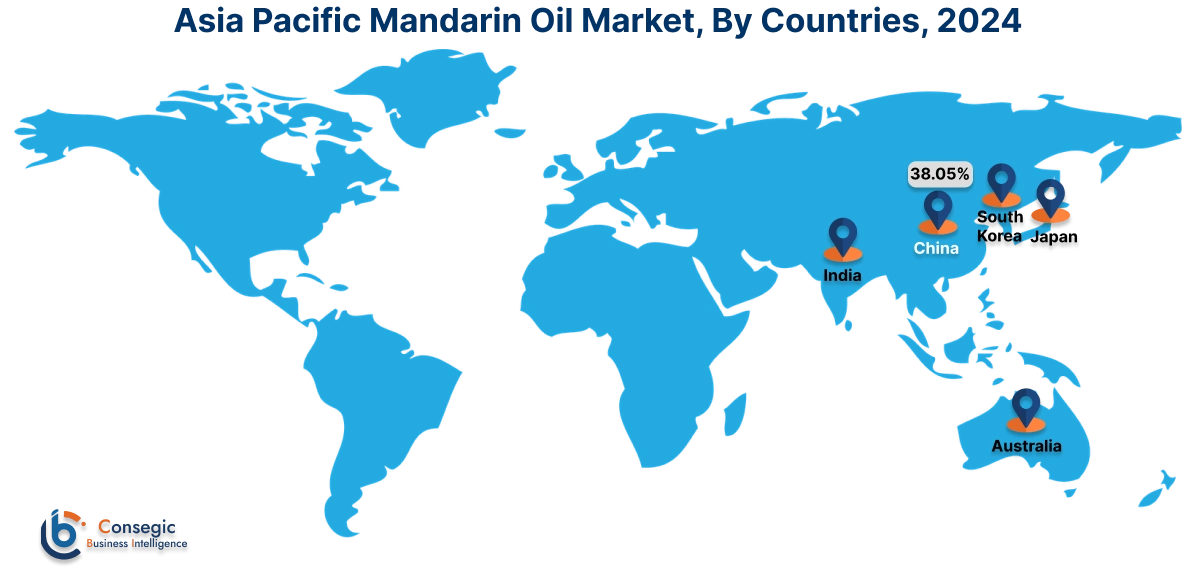
In Europe, the mandarin oil industry is experiencing the fastest growth with a CAGR of 7.1% over the forecast period. The region's emphasis on natural and organic cosmetics is a significant factor. Italy serves as one of the largest producers of this oil. Europe has a well-established aromatherapy and wellness sector. The calming and uplifting properties of this oil make it a popular choice for aromatherapy applications. Moreover, the presence of stringent environmental regulations across the European Union favors the use of natural ingredients, further influencing the requirement and sourcing of this oil within the region. These factors collectively present a positive impact on the European market analysis.
As per North America market analysis, demand is significantly defined by a confluence of factors across key end-use sectors. In North America, the well-established food & beverage sector is a significant consumer of the oil utilizing it as a natural flavoring agent. Consumers are increasingly seeking products free from synthetic additives in cosmetics, personal care, and food & beverage. This multifaceted adoption, coupled with a focus on sustainable industrial practices, positions North America as a significant market for this oil.
The Latin American mandarin oil market trend is driven by the growing cosmetics & personal care sector benefiting from rising disposable incomes and influential beauty trends, leading to a greater requirement for effective skincare ingredients like the essential oil of mandarin oranges. The growing preference for natural and plant-derived ingredients further supports the adoption of this oil. Additionally, the expanding industrial base across Latin America is creating demand for this oil in the food and beverage industry. Hence, as per analysis, these aforementioned factors are creating mandarin oil market opportunities in the region.
The mandarin oil market analysis in the Middle East and Africa (MEA) is currently witnessing an increase in awareness and adoption of essential oils and natural products. Additionally, there's a growing interest in aromatherapy and holistic wellness practices in the Middle East and Africa. Furthermore, the developing manufacturing sector in several MEA nations is anticipated to boost the consumption trend of the compound in applications such as food & beverage products and cosmetics.
Top Key Players and Market Share Insights:
The Global Mandarin Oil Market is highly competitive with major players providing products to the national and international markets. Key players are adopting several strategies in research and development (R&D) and product innovation to hold a strong position in the global Mandarin Oil market. Key players in the Mandarin Oil industry include
- International Flavors & Fragrances Inc. (U.S.)
- Ultra International B.V. (Netherlands)
- MCI Miritz (Germany)
- Young Living Essential Oils, LC. (U.S.)
- Ernesto Ventós S.A. (Spain)
- dōTERRA (U.S.)
- Biolandes (France)
- Citrus and Allied Essences Ltd. (U.S.)
- AOS Products Pvt. Ltd. (India)
- Simone Gatto (Italy)
Mandarin Oil Market Report Insights :
| Report Attributes | Report Details |
| Study Timeline | 2019-2032 |
| Market Size in 2032 | USD 549.14 Million |
| CAGR (2025-2032) | 5.3% |
| By Application |
|
| By End Use |
|
| By Region |
|
| Key Players |
|
| North America | U.S. Canada Mexico |
| Europe | U.K. Germany France Spain Italy Russia Benelux Rest of Europe |
| APAC | China South Korea Japan India Australia ASEAN Rest of Asia-Pacific |
| Middle East and Africa | GCC Turkey South Africa Rest of MEA |
| LATAM | Brazil Argentina Chile Rest of LATAM |
| Report Coverage |
|
Key Questions Answered in the Report
How big is the Mandarin Oil market? +
In 2024, the Mandarin Oil market is USD 364.52 Million.
Which is the fastest-growing region in the Mandarin Oil market? +
Europe is the fastest-growing region in the Mandarin Oil market.
What specific segmentation details are covered in the Mandarin Oil market? +
By Application and End Use segmentation details are covered in the Mandarin Oil market.
Who are the major players in the Mandarin Oil market? +
International Flavors & Fragrances Inc. (U.S.), Ultra International B.V. (Netherlands), dōTERRA (U.S.) are some of the major players in the market.
